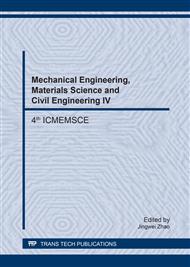[1]
Gowran, A., et al., Tissue Engineering of Cartilage; Can Cannabinoids Help? Pharmaceuticals (Basel), 2010. 3(9): pp.2970-2985.
DOI: 10.3390/ph3092970
Google Scholar
[2]
Rodriguez-Vazquez, M., et al., Chitosan and Its Potential Use as a Scaffold for Tissue Engineering in Regenerative Medicine. Biomed Res Int, 2015. 2015: p.821279.
Google Scholar
[3]
Gu, Y., et al., Chitosan/silk fibroin-based, Schwann cell-derived extracellular matrix-modified scaffolds for bridging rat sciatic nerve gaps. Biomaterials, 2014. 35(7): pp.2253-63.
DOI: 10.1016/j.biomaterials.2013.11.087
Google Scholar
[4]
Sun, Y., Q. Yang, and H. Wang, Synthesis and Characterization of Nanodiamond Reinforced Chitosan for Bone Tissue Engineering. J Funct Biomater, 2016. 7(3).
Google Scholar
[5]
Gomathysankar, S., A.S. Halim, and N.S. Yaacob, Proliferation of keratinocytes induced by adipose-derived stem cells on a chitosan scaffold and its role in wound healing, a review. Arch Plast Surg, 2014. 41(5): pp.452-7.
DOI: 10.5999/aps.2014.41.5.452
Google Scholar
[6]
Krajewska, B., Membrane-based processes performed with use of chitin/chitosan materials. Separation and Purification Technology, 2005. 41(3): pp.305-312.
DOI: 10.1016/j.seppur.2004.03.019
Google Scholar
[7]
Luo, H., J. Li, and X. Chen, Potential role of N-Succinyl-Chitosan in immune reconstitution after umbilical cord blood transplantation in mice. Biomedicine & Pharmacotherapy, 2011. 65(8): pp.578-584.
DOI: 10.1016/j.biopha.2010.01.011
Google Scholar
[8]
Skop, N.B., et al., Heparin crosslinked chitosan microspheres for the delivery of neural stem cells and growth factors for central nervous system repair. Acta Biomater, 2013. 9(6): pp.6834-43.
DOI: 10.1016/j.actbio.2013.02.043
Google Scholar
[9]
Sivashankari, P.R. and M. Prabaharan, Prospects of chitosan-based scaffolds for growth factor release in tissue engineering. International Journal of Biological Macromolecules.
DOI: 10.1016/j.ijbiomac.2016.02.043
Google Scholar
[10]
Yu, P., et al., Self-assembled high-strength hydroxyapatite/graphene oxide/chitosan composite hydrogel for bone tissue engineering. Carbohydrate Polymers, 2017. 155: pp.507-515.
DOI: 10.1016/j.carbpol.2016.09.001
Google Scholar
[11]
Muthukumar, T., et al., Collagen/chitosan porous bone tissue engineering composite scaffold incorporated with Ginseng compound K. Carbohydrate Polymers, 2016. 152: pp.566-574.
DOI: 10.1016/j.carbpol.2016.07.003
Google Scholar


